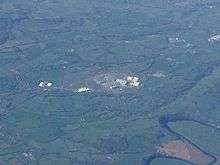Samlesbury Aerodrome
| Samlesbury Aerodrome | |||||||||||
|---|---|---|---|---|---|---|---|---|---|---|---|
|
IATA: none – ICAO: | |||||||||||
| Summary | |||||||||||
| Airport type | Private | ||||||||||
| Operator | BAE Systems | ||||||||||
| Location | Balderstone | ||||||||||
| Elevation AMSL | 55 ft / 17 m | ||||||||||
| Coordinates | 53°46′24″N 002°34′10″W / 53.77333°N 2.56944°WCoordinates: 53°46′24″N 002°34′10″W / 53.77333°N 2.56944°W | ||||||||||
| Map | |||||||||||
 Samlesbury Aerodrome Location in the Borough of Ribble Valley | |||||||||||
| Runways | |||||||||||
| |||||||||||
Samlesbury Aerodrome is a disused airfield at Balderstone near Samlesbury, in the Ribble Valley district of Lancashire. The aerodrome is owned by defence company BAE Systems which uses the site for manufacturing of several aircraft types. Currently BAE employ approximately 3,000 people at the site. The aerodrome is part of Lancashire Enterprise Zone.
History
The origins of the site, which was once an active aerodrome, date back to 1922 when it was proposed that a municipal airfield be constructed to serve the nearby towns of Blackburn and Preston. However, construction did not commence on the airfield until April 1939, then accelerated because of the Second World War, when the Air Ministry instructed the English Electric Company (EE) to proceed with the construction of flight shed number 1. The first of the Handley Page Hampdens built by EE made its maiden flight on 22 February 1940,[1] and by 1942 770 Hampdens had been delivered from Samlesbury. In 1940 a second factory was built and the runway was extended so that construction of the Handley Page Halifax could begin. By 1945 all five main hangars and three runways had been completed. During the war the site was also home to No. 9 Group RAF who flew Hawker Hurricanes and Airspeed Oxfords from the site. By the end of the war over 3,000 bombers had been built and flown from Samlesbury.
After the war aircraft such as the De Havilland Vampire, the English Electric Canberra (the first aircraft designed and built wholly by English Electric) and the English Electric Lightning were built on the site. The site has also produced parts for the Anglo-French Concorde and the ill-fated TSR2 project. When English Electric merged to become BAC and later British Aerospace it worked closely with the nearby sister plant at BAE Warton and the former BAE factory in Preston on building the Sepecat Jaguar and Panavia Tornado fighter aircraft.
In 2009, 635 Volunteer Gliding Squadron of the Royal Air Force moved its operation to RAF Topcliffe. Motor gliding no longer takes place at Samlesbury because of the airfield's closure. The aerodrome's ICAO code of EGNG has been reassigned to Bagby airfield in Yorkshire.

BAE Systems use
Today the Samlesbury facility is a high-technology BAE Systems manufacturing and aerospace facility. Spirit AeroSystems also occupies a small area of Samlesbury after the BAE Systems Aerostructures business was sold to Spirit AeroSystems in 2006. Spirit manufactures parts for the Airbus and other civil platforms at the site.
The current site, which employs over 3,000 people, builds the fuselage and other parts for the Eurofighter Typhoon and other aircraft including the American F-35 Lightning II and the T-45 Goshawk. The site has also seen the construction of a large block to house BAE office staff. The airstrip itself still exists, serving aircraft of the 635 Volunteer Gliding Squadron until 2009 using the Vigilant T.1 (military variant of the Grob 109B) despite the runway being classed as inactive. During 2006 BAE Systems transferred ownership of the site to its Pension Fund Scheme. There are now ongoing plans to develop a high-tech aerospace business park on the airfield. Phase one of the building works began in November 2007, projected to take a year to complete. In 2008 work began on the construction of a new main entrance and visitor's centre at the western boundary of the site; this is now in operation.
Until recently the site had two gate guards, adjacent to the old site entrance. One was a Lightning F.53 (ZF580), removed in February 2013.[2] The Lightning was painted in generic RAF aircraft markings as worn after return from the Royal Saudi Air Force (RSAF) where it bore serial 53-672. This was returned to the UK around 1986 (with 2,305 flying hours) when British Aerospace sold Tornado aircraft to the RSAF as part of the Al Yamamah deal. The removal of the Lightning was met with "local anger".[3]
Until November 2009 there was also a Canberra PR.7 (WT537) as a gate guard but this has been removed for restoration at the (now closed) RAF Millom Aviation and Military Museum at Haverigg, Cumbria.
A full-size plastic F-35 Lightning II and a plastic Lighting F.35 (created using a mould from the original plane) will be the site's gate guard in the summer of 2015.
Enterprise zone
Since 2012, the aerodrome has provided one of the two sites of Lancashire Enterprise Zone, the other site being at BAE Systems' Warton Aerodrome.[4] The zone's site at Samlesbury covers 74 hectares (180 acres).[5] BAE Systems, Lancashire County Council and Lancashire Enterprise Partnership coordinate the site's development.[4]
References
| Wikimedia Commons has media related to Samlesbury Aerodrome. |
- ↑ Smith, David J. (1981). Action Stations 3 Military airfields of Wales and the North-West. Patrick Stephens. p. 157. ISBN 0-85059-485-5.
- ↑ http://www.lancashiretelegraph.co.uk/news/samlesbury/10259121.BAE_Systems_scraps_iconic_Samlesbury_gateway_jet/
- ↑ http://www.lep.co.uk/news/local/anger-as-iconic-bae-gateway-jet-is-removed-1-5464910
- 1 2 Dillon, Jonathon (26 February 2012). "'Big companies' interested in East Lancashire enterprise zone". Lancashire Telegraph. Retrieved 26 March 2015.
- ↑ Woodhouse, Lisa (23 August 2012). "Lancashire enterprize zone due in to boost jobs 18 months". Lancashire Telegraph. Retrieved 26 March 2015.